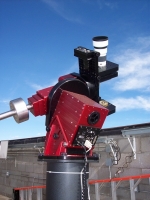Displaying items by tag: KELT North telescope
KELT-North telescope
The Kilodegree Extremely Little Telescope (KELT) project of the Ohio State University is an effort to find the best way to discover planetary transits of bright stars and to implement that method by building a telescope and discovering planets.
" In order to learn how to design a survey for transits of bright stars, we start by constructing a model of an all-sky survey for transits. That model points to an optimal survey configuration that uses a small-aperture, wide-field telescope to search for transits of stars in the range 8 < V < 10 magnitude. We used the parameters suggested by the model to build the KELT telescope, and we have deployed it to Winer Observatory in Arizona and begun a long-term survey for planets in a series of fields around the sky. The survey area covers about 25% of the Northern hemisphere and should allow us to detect the most scientifically valuable transiting planets. We examine the performance of the telescope with a number of metrics, and we find that it is performing at the level needed to detect the types of transits we are seeking. We have completed the analysis of the first data set from KELT - a commissioning run from early 2005 that observed the Praesepe open cluster over 74 nights. We obtained light curves of 69,337 stars, and detected 58 long period variables and 153 periodic variables. Sixteen of these are previously known variables, yielding 195 newly discovered variables for which we provide properties and light curves. We also searched for planetary-like transits, finding four transit candidates. Follow-up observations indicate that three of the candidates are astrophysical false positives, with one candidate inconclusively characterized. "
The Ohio State University telescope is also known as KELT-North since a twin project, KELT-South, was setup in South Africa to cover the South part of the sky.


